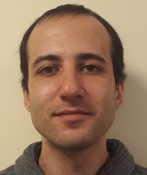Program Information
A Novel Method Using Surface Monitoring to Capture Breathing-Induced Cycle-To-Cycle Variations with 4DCT
P Sabouri1*, M Foote2 , M Ranjbar1 , M Tajdini1 , S Mossahebi1 , S Joshi2 , A Sawant1 , (1) University of Maryland School of Medicine, Baltimore, MD, (2) The University of Utah, Salt Lake City, UT
Presentations
TH-EF-605-10 (Thursday, August 3, 2017) 1:00 PM - 3:00 PM Room: 605
Purpose: Respiratory-correlated 4DCT is the standard-of-care in motion-managed radiotherapy. However, 4DCT does not capture cycle-to-cycle breathing variations, potentially leading to geometric and dosimetric errors. We investigate a multi-cycle 4DCT that uses the same acquisition technique (therefore, imaging dose) as clinical 4DCT and is parameterized by real-time surface photogrammetry (VisionRT).
Methods: Diffeomorphic image registration was used to calculate deformation vector fields (DVFs) of each 4DCT phase with respect to end-of-exhale (phase50%). The first two principal components (PC) were used to reduce dimensionality. Concurrently, the thoracic surface was captured (25Hz) using a prototype, couch-mounted VisionRT system. Ten phase-averaged VisionRT surfaces were assembled using the first PC of the surface time-series. For each phase-averaged surface, the deformation with respect to the end-of-exhale VisionRT surface was used with a principal-least-square model in order to correlate the phase-averaged surface deformations with CT-DVF PCs. Subsequently, the model was applied to the surface time-series to estimate PC weights of CT-DVFs. Validation was performed using 4DCT and fluoroscopic measurements of a programmable deformable lung phantom and retrospective data from a lung cancer patient.
Results: For the phantom study, compared to the ground-truth fluoroscopic data, the model and the 4DCT exhibited RMS errors as large as 3.31mm and 8.09mm, respectively. For all five embedded markers, the model estimated the SI displacement margin to within 15% of fluoroscopy while 4DCT systematically underestimated the margin by as much as 50%. For the patient study, the difference between the model predicted displacements of a 3x6mm2 patch on the diaphragm with respect to 4DCT is found to have a RMS error of 2.1324mm.
Conclusion: In the presence of cycle-to-cycle variations, 4DCT is susceptible to geometric errors. Our proposed model can capture such variations by generating volume deformations that account for short-term irregularities in the breathing cycle.
Funding Support, Disclosures, and Conflict of Interest: This work was supported by NIH R01 CA169102.
Contact Email:
